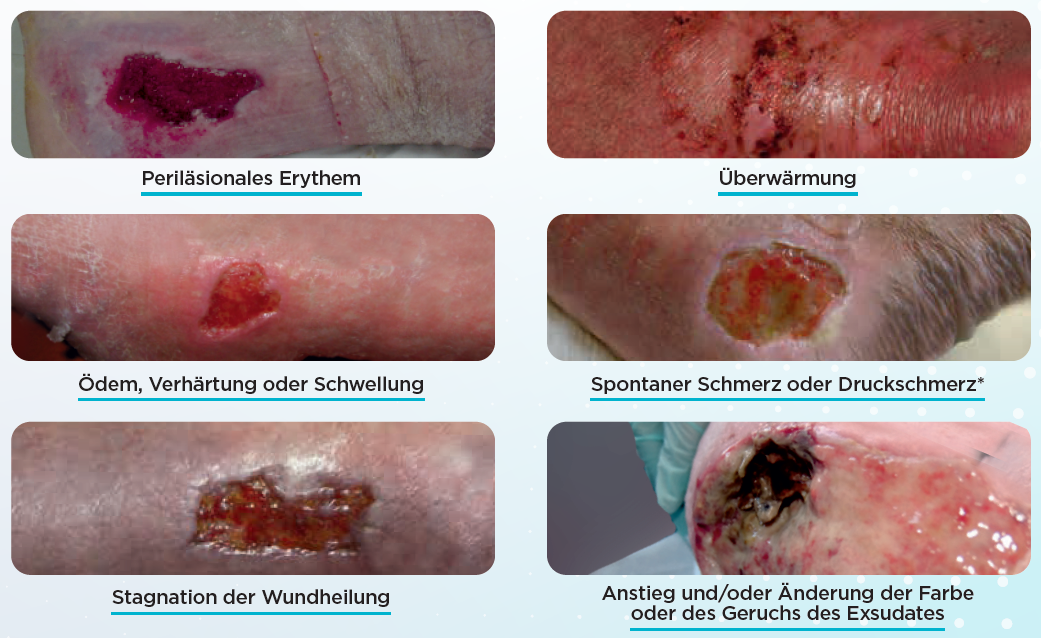Keine gefährdete oder infizierte Wunde ist eine saubere Wunde. Zelltrümmer und Exsudat sorgen für ein ideales Umfeld für mikrobielle Vermehrung und Biofilmbildung (1).
Seite aktualisiert am 22 März 2022
Startseite » Gesundheitsexperten » Wunden verstehen und heilen » Wie behandelt man eine Wundinfektion?

Wenn mindestens 5 dieser 6 indikativen Parameter auf einer Wunde vorhanden sind, wird eine sofortige Anwendung einer lokalen antimikrobiellen Behandlung empfohlen (2;3).
Eine wirksame Bekämpfung der lokalen Infektion erfordert eine kombinierte antimikrobielle und reinigende Maßnahme.
WUSSTEN SIE SCHON? – Biofilm
Wenn die Wundheilung aufhört und die Wunde statisch wird, dann ist es möglich, dass die Wunde einen Biofilm auf der Oberfläche entwickelt hat, der eine weitere Heilung verhindert. Möglicherweise gibt es noch andere Faktoren, aber wir wissen, dass 80 % der chronischen Wunden einen Biofilm haben, und wenn dieser nicht aufgebrochen und beseitigt wird, wird die Wunde ad infinitum in einem statischen Zustand bleiben.
Die biofilmbasierte Wundversorgung (4) zielt darauf ab, die Biofilmbelastung zu reduzieren durch:
– Ein effektives, schnelles Debridement
– Eine kräftige Reinigung
– Einen antimikrobiellen Verband

Diese Website verwendet Cookies (Dateien, die auf Ihrem Gerät installiert werden, wenn Sie diese Website besuchen), um die Nutzung dieser Website zu messen.
Sie können die Installation dieser Cookies zulassen oder blockieren.
| Cookie | Dauer | Beschreibung |
|---|---|---|
| cookielawinfo-checkbox-analytics | 1 year | Das Cookie wird durch die DSGVO-Cookie-Zustimmung gesetzt, um die Zustimmung des Nutzers für die Cookies in der Kategorie „Statistiken“ zu erfassen. |
| cookielawinfo-checkbox-necessary | 1 year | Das Cookie wird durch die DSGVO-Cookie-Zustimmung gesetzt, um die Zustimmung des Nutzers für die Cookies in der Kategorie „Essenziell“ zu erfassen. |
| cookielawinfo-checkbox-social-media | 1 year | Das Cookie wird durch die DSGVO-Cookie-Zustimmung gesetzt, um die Zustimmung des Nutzers für die Cookies in der Kategorie „Externe Medien“ zu erfassen. |
| Cookie | Dauer | Beschreibung |
|---|---|---|
| _ga | 2 years | Enthält eine zufallsgenerierte User-ID. Anhand dieser ID kann Google Analytics wiederkehrende User auf dieser Website wiedererkennen und die Daten von früheren Besuchen zusammenführen. |
| _gat_gtag_xxx | 1 minute | Bestimmte Daten werden nur maximal einmal pro Minute an Google Analytics gesendet. Das Cookie hat eine Lebensdauer von einer Minute. Solange es gesetzt ist, werden bestimmte Datenübertragungen unterbunden. |
| _gid | 1 day | Enthält eine zufallsgenerierte User-ID. Anhand dieser ID kann Google Analytics wiederkehrende User auf dieser Website wiedererkennen und die Daten von früheren Besuchen zusammenführen. |
